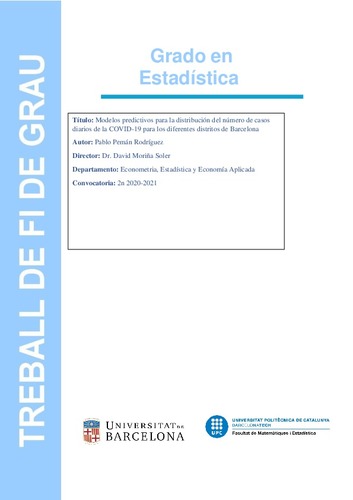Modelos predictivos para la distribución del número de casos diarios de la COVID-19 para los diferentes distritos de Barcelona

Visualitza/Obre
Estadístiques de LA Referencia / Recolecta
Inclou dades d'ús des de 2022
Cita com:
hdl:2117/365068
Tutor / directorPemán Rodríguez, Pablo
Tipus de documentTreball Final de Grau
Data2021
Condicions d'accésAccés obert
Llevat que s'hi indiqui el contrari, els
continguts d'aquesta obra estan subjectes a la llicència de Creative Commons
:
Reconeixement-NoComercial-SenseObraDerivada 3.0 Espanya
Abstract
La COVID-19 ha afectado a toda la
sociedad, es por ello por lo que hemos
considerado necesario ajustar modelos
que nos permitan explicar y predecir la
serie temporal de los casos detectados.
Al ser la COVID-19 una enfermedad
infecciosa, donde los casos de un día
vienen influenciados por los días
anteriores, consideramos que los mejores
modelos para explicar la serie serán los
autorregresivos, en concreto, los AR y
los INAR. Analizaremos la serie en
función del sexo y el distrito. A nivel de
resultados obtenemos diferentes
mecanismos en ambos modelos en
función del sexo, y también vemos como
los barrios con mayor población o
densidad poblacional son aquellos con
más tendencia a detectar más casos.
Comparando los modelos, se observa
claramente que el modelo INAR es
superior en todos los aspectos al modelo
AR, teniendo en cuenta que nuestra serie
no es estacionaria, y, por tanto, ninguno
es perfecto. COVID-19 has affected the whole of
society, which is why we have
considered it necessary to adjust models
that allow us to explain and predict the
time series of the detected cases. As
COVID-19 is an infectious disease,
where the cases of one day are
influenced by the previous days, we
consider that the best models to explain
the series will be the autoregressive ones,
specifically, the AR and the INAR. We
will analyze the series as a function of
sex and district. At the level of results,
we obtain different mechanisms in both
models as a function of sex, and we also
see how the districts with higher
population or population density are
those with a greater tendency to detect
more cases. Comparing the models, it is
clearly observed that the INAR model is
superior in all aspects to the AR model,
taking into account that our series is not
stationary, and, therefore, neither is
perfect
TitulacióGRAU EN ESTADÍSTICA (Pla 2009)
Col·leccions
| Fitxers | Descripció | Mida | Format | Visualitza |
|---|---|---|---|---|
| TFG_PabloPemanRodriguez.pdf | 2,434Mb | Visualitza/Obre |


